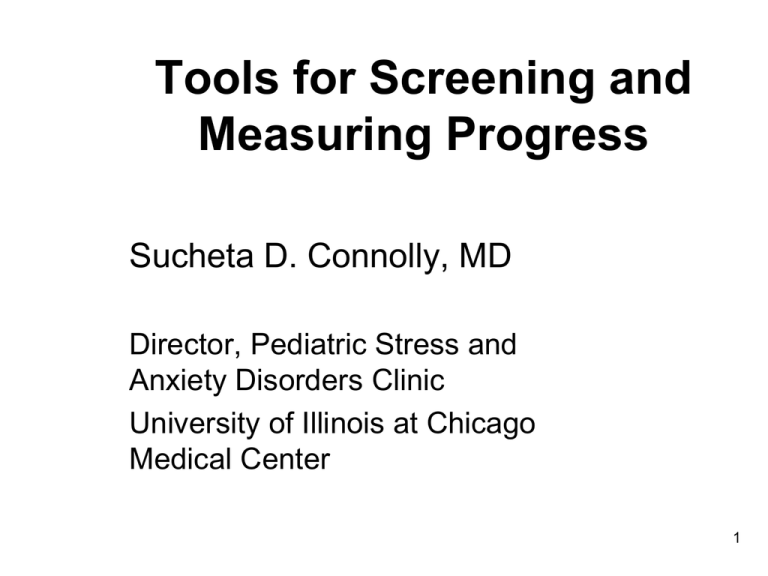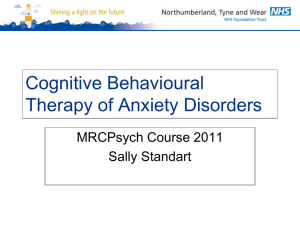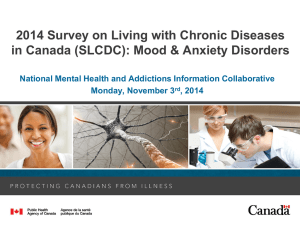Tools for Screening and Measuring Progress
advertisement

Tools for Screening and Measuring Progress Sucheta D. Connolly, MD Director, Pediatric Stress and Anxiety Disorders Clinic University of Illinois at Chicago Medical Center 1 Screening for Anxiety Disorders • Childhood anxiety disorders are common and often co-occur (8-10%) • Routinely include screening for anxiety symptoms as part of any child and adolescent evaluation • Obtain information from multiple informants (child, parent, school) 2 Tools for Screening and Measuring Progress: Anxiety Disorders • BASC & CBCL broad band measures completed by child, parent, and teacher (parent & teacher report for young children) • Alternative Vanderbilt Assessment Scale* (parent & teacher report) • Pediatric Symptom Checklist*(parent/child) • MASC (March et al., 1997) and SCARED* (Birmaher et al., 1999) anxiety self-report measures for 8 years and older • Sensitive to change & treatment progress • (*) available with open access on line 3 Tools for Screening and Measuring Progress: Comorbid Disorders • CDI self-report for depression • Conner’s parent & teacher report for ADHD (alternative Vanderbilt) • Both of these are sensitive to change & treatment progress • Screen for substance abuse (CRAFFT) • Consider LD, language disorders, PDD 4 Adolescent Substance Abuse Screening: CRAFFT Six-item measure that assesses for problematic substance use among adolescents This measure is very brief and can be given as a standard part of an initial assessment to screen for likelihood of a substance use disorder. Two or more “yes” responses are suggestive of a probable substance use disorder and should be followed up with a more in-depth assessment. 5 Adolescent Substance Abuse Screening: CRAFFT 1. Have you ever ridden in a Car driven by someone (including yourself) who was “high” or had been using alcohol or drugs? 2. Do you ever use alcohol or drugs to Relax, feel better about yourself, or fit in? 3. Do you ever use alcohol/drugs while you are by yourself, Alone? 4. Do your Family or Friends ever tell you that you should cut down on your drinking or drug use? 5. Do you ever Forget things you did while using alcohol or drugs? 6. Have you gotten into Trouble while you were using alcohol or drugs? (Two or more yes answers suggests risk for substance 6 use disorder) T-Scores And What They Mean • • • • • • Mean T-score = 50 Standard deviation (sd) = 10 T-scores from 40-60: Average range 65-70: Borderline significant (top 5%) 70 or higher: Clinically significant (top 2%) T-scores 39 and below: Low • Do not need to be a clinician to score and interpret these screening measures: CBCL or BASC (broad-band), MASC (anxiety), CDI 7 (dep), Conner’s (ADHD) Selective Mutism Questionnaire (R. L. Bergman Ph.D.) • Parent report and teacher report • Items relate to situations in school, with family, in social situations outside school, and “other” situations • Parents rate how often child interacts with others • Behavior and interference ratings • Research measure under development 8 Assessment of Anxiety Disorders •ADIS-C •Differential Diagnosis •Severity and Impairment 9 • Differential Diagnosis and Assessment of Anxiety Disorders If screening indicates significant anxiety, evaluate further for specific anxiety disorders • Distinguish from normal fears, worries, and responses to stressors or trauma • Evaluate severity and functional impairment of anxiety disorders and comorbid disorders • Consider differential diagnosis with other psychiatric and medical disorders 10 ADIS-DSM-IV-Child Version • ADIS-DSM-IV-Child Version (Silverman & Albano, 1996) for youth 6-17 years old to supplement clinical interview (parent and child interview schedule) • Considered Gold Standard • Feelings Thermometer to assess severity, functional impairment (interference), and monitor progress • Developmentally appropriate language and situations that apply to youth • Assessment of commonly comorbid disorders 11 (ADHD, depression, dysthymia) Differentiating Anxiety Disorders • • • • • SAD GAD Social Phobia Specific Phobia Panic Disorder • Selective mutism • OCD • PTSD 12 Differentiating from Physical Conditions Physical conditions with anxiety-like symptoms: hyperthyroidism, caffeinism (soda), migraine, seizure disorders, lead intoxication, pheochromocytoma, cardiac, etc. Medication side effects: prescription (antiasthmatics, steroids, sympathomimetics) and non-prescription drugs (cold medicines, antihistamines) Somatic symptoms commonly associated (stomachaches, headaches), consider MHA 13 early in medical evaluation Differential Dx: Psychiatric Psychiatric conditions (similar symptoms): ADHD (restlessness, inattention) Psychotic disorders (restlessness, social withdrawal) PDD (social awkwardness, social communication deficits, repetitive behaviors, adherence to routines) LD (worries about school performance) Bipolar disorder (restlessness, irritability, insomnia) Depression (poor concentration, sleep problems, somatic complaints) 14 Tools to Assess and Monitor Severity and Impairment • Feelings Thermometer to assess severity, functional impairment (interference), and monitor progress • Feelings Barometer can include faces rather than numbers, or link the two • Choose developmentally appropriate tool young children may use 1-2-3 faces scale 15











